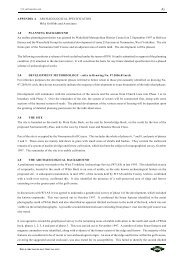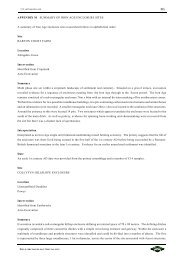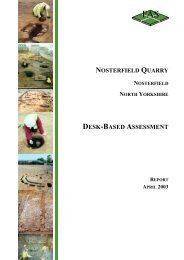ARCHAEOLOGICAL EVALUATION - Mike Griffiths and Associates
ARCHAEOLOGICAL EVALUATION - Mike Griffiths and Associates
ARCHAEOLOGICAL EVALUATION - Mike Griffiths and Associates
Create successful ePaper yourself
Turn your PDF publications into a flip-book with our unique Google optimized e-Paper software.
FAS_lbf01.wpd 69<br />
8.0 <strong>EVALUATION</strong> EXCAVATION<br />
The trial trench excavation programme was carried out in three phases. The first phase consisted of four 100m<br />
x 4m trenches <strong>and</strong> three 50m x 4m trenches, <strong>and</strong> was undertaken in Zone D during March 2004. The second<br />
phase involved the h<strong>and</strong>-excavation of nine trenches in Zone C during April 2004. The final phase comprised<br />
ten 100m x 4m trenches, two 50m x 8m trenches <strong>and</strong> seven 50m x 4m trenches in Zones A, B, <strong>and</strong> E. This<br />
fieldwork was carried out between August 2004 <strong>and</strong> October 2004 (Figure 36).<br />
While the trenching regime was designed to provide an adequate coverage of the area of investigation, cropmark<br />
features, lithic concentrations <strong>and</strong> anomalies identified by the geophysical surveys were targeted with trenches<br />
for further investigation. The evaluation excavation programme provides a 2% excavation sample of the<br />
application area. The use of long rectangular trenches on mixed orientations was adopted to improve the<br />
probability of intersecting boundary features.<br />
8.1 FIELDWORK PROCEDURE<br />
The corners of the trenches were set out using a total station<br />
theodolite. The edges of the trenches were then marked.<br />
Ploughsoil <strong>and</strong> topsoil deposits were excavated using a tracked<br />
mechanical excavator fitted with a broad toothless ditching<br />
bucket under strict archaeological supervision (Plate 5). Areas<br />
which were considered to contain possible features were h<strong>and</strong>cleaned<br />
to improve definition.<br />
Nine h<strong>and</strong>-excavated trenches (Interventions 14 to 22) were<br />
Plate 5 Machining of an evaluation trench<br />
positioned to investigate the lithic concentration defined by<br />
fieldwalking in Zone C, in order to test for the presence of a lithic assemblage within the ploughsoil <strong>and</strong> whether<br />
any such distribution related to plough-damaged features. In each trench, a series of test pits were initially<br />
excavated (see section 7.1), <strong>and</strong> the remaining ploughsoil was then removed by h<strong>and</strong> down to the top of the<br />
natural subsoil. The entire trench was then h<strong>and</strong>-cleaned. This was undertaken to ensure that the significance<br />
of any lithic distribution within the ploughsoil was fully appreciated prior to the disturbance of larger areas of<br />
ploughsoil by machine excavated evaluation trenches (see section 7.2).<br />
All features were h<strong>and</strong> cleaned to improve definition <strong>and</strong> facilitate recording. An appropriate sample of the<br />
feature was then established <strong>and</strong> excavated. In most cases, small isolated features were half-sectioned; however,<br />
when these features were considered to be significant <strong>and</strong> would not survive backfilling, the entire feature was<br />
excavated. Written, drawn <strong>and</strong> photographic records were made of all archaeological deposits.<br />
The recording system followed Field Research Procedure (Carver 1999), the st<strong>and</strong>ard operating system<br />
employed by FAS. A single index was maintained for contexts <strong>and</strong> for features, which continued from those<br />
context <strong>and</strong> feature numbers allocated during Phase 1 evaluation. A checklist of records created during<br />
excavation, which form the content of the archive, is given below (Appendix D); context <strong>and</strong> feature record<br />
summaries form Appendix E.<br />
FIELD ARCHAEOLOGY SPECIALISTS







